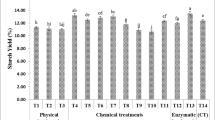Summary
A rapid quantitative method for tuber protein is needed for screening large populations of potatoes in a breeding program. The Neotec Grain Quality Analyzer, the Orange G or Udy method and the Bromphenol Blue dye-binding method have been evaluated. Protein values determined by Neotec or Orange G did not correlate with those from routine methods. Protein values determined by the Bromphenol Blue method correlate well with those determined by the Potty procedure and amino acid analyses.
Zusammenfassung
In einem Programm zur Züchtung von Kartoffeln mit erhöhtem Proteingehalt wird eine Schnellmethode benötigt, um das Screening grosser Populationen zu bewerkstelligen. Die angewandten Schnellmethoden sind: Mikro-Kjeldahl für Protein-Stickstoff, ein abgeändertes Verfahren nach Potty für das Gesamtprotein und Aminosäureanalysen für hydrolisiertes Protein (Desborough et al., 1973). In diesem Beitrag wird über mengenmässige Schätzungen von Protein mittels des Neotex Quality Grain Analyzers (Rosenthal, 1973), der Udy- oder Orange G-Methode (Udy, 1956) und der Bromphenolblau (BPB)-Färbemethode (Swaminathan et al., 1973) berichtet. In den meisten Versuchen wurde gefriergetrocknetes Pulver von Kartoffeln mit verschiedener genetischer Abstammung analysiert. Die Pflanzen wurden auf dem Feld in Sturgeon Bay, Wisconsin, oder Grand Rapids, Minnesota, angebaut. Die Proteinwerte aus den Neotex-Bestimmungen wurden mit den Proteinwerten nach Potty verglichen (Abb. 1). Die Menge von an Protein gebundenem Orange G wurde mit dem Protein-Stickstoff verglichen (Abb. 2); und die BPB-Methode zur Proteinbestimmung wurde mit dem Potty-Verfahren verglichen (Abb. 5 und 6). Die BPB-Methode wurde als eine schnelle Mengenbeurteilungsmethode für Protein befunden, und ihre Werte korrelieren gut mit jenen des Potty-Verfahrens (Tabellen 1 und 2). Unsere Standard-BPB-Methode wurde vorgestellt und in bezug auf Proteinbestimmungen in gefriergetrockneten Kartoffelpulvern diskutiert (Abb. 3 und 4).
Résumé
Tout programme d'amélioration pour accroître la protéine dans les tubercules de pomme de terre exige une méthode rapide de sélection quantitative pour la sélection dans de grandes populations. Les méthodes de routine employées sont: le micro-Kjeldahl pour l'azote protéinique, le procédé modifié de Potty pour la protéine totale, et les analyses acides amine's de la protéine hydrolysée (Desborough et al. 1973). Le présent article rapporte les estimations quantitatives de protéine par l'analyseur de qualité du grain Neotec (Rosenthal 1973), la méthode Udy et Orange G (Udy, 1956) et la méthode par coloration au bleu de bromphénol (BPB) (Swaminathan et al. 1973). Dans la plupart des essais, on analyse des poudres de pommes de terre séchées et gelées de diverses bases génétiques. Les plantes sont poussées au champ à Sturgeon Bay, Wisconsin ou à Grand Rapids, Minnesota. Les valeurs en protéine des déterminations Neotec sont comparées avec les valeurs en protéine Potty (fig. 1); la quantité de protéine retenue par Orange G est comparées avec l'azote protéinique (fig. 2); et la méthode BPB est comparée avec le procédé Potty (fig. 5 et 6). La méthode BPB est choisie pour l'estimation quantitatieve rapide de la protéine et les valeurs correspondent bien avec celles obtenues par le procédé Potty (tableaux 1 et 2). Les auteurs présentent et discutent leur méthode standard BPB pour la détermination de la protéine des poudres de pommes de terre séchées et gelées (fig. 3 et 4).
Similar content being viewed by others
References
Anfinsen Jr. C. B., M. L. Anson & J. T. Edsall (Ed.), 1963. Advances in protein chemistry. Academic Press, New York.
Desborough, S. & C. J. Weiser, 1972. Protein comparisons in selected Phureja-Haploid Tuberosum families.Am. Potato J. 49: 227–233.
Desborough, S. & C. J. Weiser, 1974. Improving potato protein. I. Evaluation of selection techniques.Am. Potato J. 51: 185–196.
Fraenkel-Conrat, H. & M. Cooper, 1944. The use of dyes for the determination of acid or basic groups in proteins.J. biol. Chem. 154: 239–246.
Gelder, W. M. J. van & C. F. Krechting, 1973. A rapid method of estimating the content of coagulable protein in potato tubers.Potato Res. 16: 311–314.
Hoff, J. E., 1974. A simple method for the approximate determination of soluble protein in potato tubers. Not published, personal communication.
Kaldy, M. S., W. Malewshi & P. Markahis, 1972. Estimation of potato protein content by dye-binding.Am. Potato J. 49: 177–181.
Long, C. (Ed.), 1961. Biochemists handbook. D. Van Nostrand, New York.
Rosenthal, R. D., 1973. The Grain Quality Analyzer. Milling and Baking Division of American Association of Cereal Chemists.
Swaminathan, K., K. C. Sud & H. Kishore, 1973. Rapid photometric method for the determination of ‘true’ protein content of potatoes based on non-selective dye-binding capacity.Indian J. exp. Biol. 11: 63–64.
Udy, D. C., 1956. Estimation of protein in wheat and flour by ion-binding.Cereal Chem. 33: 190–197.
Author information
Authors and Affiliations
Additional information
Scientific Journal Series Paper Number 8842 of the Agricultural Experiment Station.
Rights and permissions
About this article
Cite this article
Desborough, S.L. Potato protein determined by the bromphenol blue dye-binding method and other methods. Potato Res 18, 273–281 (1975). https://doi.org/10.1007/BF02361730
Accepted:
Issue Date:
DOI: https://doi.org/10.1007/BF02361730




